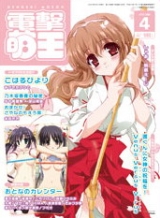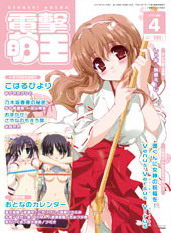
Dengeki Daioh
Encyclopedia
is a Japanese shōnen manga magazine
published by ASCII Media Works
(formerly MediaWorks
) under the Dengeki brand. Many manga serialized in Dengeki Daioh were later published in tankōbon
volumes under ASCII Media Works' Dengeki Comics
imprint
. The magazine is sold every month on the 27th. A yonkoma
section of Dengeki Daioh called features various omake
strips of the manga series published in it. The format is typically a normal drawing on the right side featuring one or sometimes more characters, and a vertical four panel strip on the left featuring characters from the associated series in super deformed
form. Two special editions of the magazine called Dengeki Moeoh and Dengeki Daioh Genesis are sold bimonthly and quarterly, respectively.
The publication originated from Bandai
's Cyber Comix magazine, which later became the short-lived Media Comix Dyne — it lasted three issues. After the publication of Media Comix Dyne was canceled, MediaWorks launched Dengeki Daioh as a quarterly publication in 1994. It eventually developed into a bimonthly magazine in 1996, and later into a monthly publication when its name was changed to its current title, Monthly Comic Dengeki Daioh. In recent years, the magazine has taken to publishing information on anime
and video games as well where half the magazine contains such information. Dengeki Daioh celebrated its thirteenth year of publication in 2007. Starting with the August 2008 issue, sold on June 27, 2008, Dengeki Daioh increased the number of manga series serialized in each issue which expanded the page count from about 700 to 900 pages per issue.
 Dengeki Moeoh
Dengeki Moeoh
Dengeki Teioh
Comic Sylph
Dengeki Bunko Magazine
Magazine
Magazines, periodicals, glossies or serials are publications, generally published on a regular schedule, containing a variety of articles. They are generally financed by advertising, by a purchase price, by pre-paid magazine subscriptions, or all three...
published by ASCII Media Works
ASCII Media Works
is a Japanese publishing company in the Kadokawa Group which formed on April 1, 2008 as a result of a merger between ASCII and MediaWorks where MediaWorks legally absorbed ASCII. Despite this, the former president of ASCII, Kiyoshi Takano, became the president of ASCII Media Works. The company...
(formerly MediaWorks
MediaWorks (publisher)
was a Japanese publishing company in the Kadokawa Group known for their brand magazines and book labels. These included such well-known magazines as Dengeki Daioh, and Dengeki G's Magazine, along with MediaWorks' main light novel publishing imprint Dengeki Bunko. The company was merged with ASCII...
) under the Dengeki brand. Many manga serialized in Dengeki Daioh were later published in tankōbon
Tankobon
, with a literal meaning close to "independently appearing book", is the Japanese term for a book that is complete in itself and is not part of a series , though the manga industry uses it for volumes which may be in a series...
volumes under ASCII Media Works' Dengeki Comics
Dengeki Comics
is a manga publishing label affiliated with the Japanese publishing company ASCII Media Works and is aimed at a male audience. Aside from the main Dengeki Comics label, there is the related Dengeki Comics EX label which publishes a lesser number of manga volumes...
imprint
Imprint
In the publishing industry, an imprint can mean several different things:* As a piece of bibliographic information about a book, it refers to the name and address of the book's publisher and its date of publication as given at the foot or on the verso of its title page.* It can mean a trade name...
. The magazine is sold every month on the 27th. A yonkoma
Yonkoma
thumb|right|150px|Traditional Yonkoma layout, a comic-strip format, generally consists of gag comic strips within four panels of equal size ordered from top to bottom...
section of Dengeki Daioh called features various omake
Omake
means extra in Japanese. Its primary meaning is general and widespread. It is used as an anime and manga fandom term to mean "extra or bonus". In USA, the term is most often used in a narrow sense by anime fans to describe special features on DVD releases: deleted scenes, interviews with the...
strips of the manga series published in it. The format is typically a normal drawing on the right side featuring one or sometimes more characters, and a vertical four panel strip on the left featuring characters from the associated series in super deformed
Super deformed
Super deformed or SD is a specific style of Japanese caricature where characters are drawn in an exaggerated way, typically small and chubby, with stubby limbs and oversized heads, to make them resemble small children...
form. Two special editions of the magazine called Dengeki Moeoh and Dengeki Daioh Genesis are sold bimonthly and quarterly, respectively.
The publication originated from Bandai
Bandai
is a Japanese toy making and video game company, as well as the producer of a large number of plastic model kits. It is the world's third-largest producer of toys . Some ex-Bandai group companies produce anime and tokusatsu programs...
's Cyber Comix magazine, which later became the short-lived Media Comix Dyne — it lasted three issues. After the publication of Media Comix Dyne was canceled, MediaWorks launched Dengeki Daioh as a quarterly publication in 1994. It eventually developed into a bimonthly magazine in 1996, and later into a monthly publication when its name was changed to its current title, Monthly Comic Dengeki Daioh. In recent years, the magazine has taken to publishing information on anime
Anime
is the Japanese abbreviated pronunciation of "animation". The definition sometimes changes depending on the context. In English-speaking countries, the term most commonly refers to Japanese animated cartoons....
and video games as well where half the magazine contains such information. Dengeki Daioh celebrated its thirteenth year of publication in 2007. Starting with the August 2008 issue, sold on June 27, 2008, Dengeki Daioh increased the number of manga series serialized in each issue which expanded the page count from about 700 to 900 pages per issue.
In Dengeki Daioh
In Dengeki Moeoh
- Dengeki!! Aegis 5
- Haru no Chū
- Koharubiyori
- Maromayu (spinoff of PaniponiPani Poni Dash!, also known as through its anime adaptation , is a Japanese manga series that uses parody, frequently referencing Japanese and American pop-culture in many ways...
) - Nogizaka Haruka no HimitsuNogizaka Haruka no Himitsuis a Japanese light novel series by Yūsaku Igarashi, with illustrations by Shaa. The series originally started serialization in volume thirty of MediaWorks' now-defunct light novel magazine Dengeki hp on June 18, 2004. One more chapter was published until the first bound novel of the series was...
- Omakase! Sayana no Moerobu
- Shōgakusei Sentai Petarikon
- Tōhō Kōrindō ~ Curiosities of Lotus Asia.
- Yumemitari na Hoshimatari na
- Yuriseijin Naoko-san
In Dengeki Teioh
- Hamuchu
- Iono-sama FanaticsIono-sama Fanaticsis a Japanese manga series written and illustrated by Miyabi Fujieda. The manga was serialized between the first and last issues of the now-defunct Dengeki Teioh, a special edition version of Dengeki Daioh, from April 26, 2004 until November 26, 2006, and was published by MediaWorks...
- Koharubiyori
- Kyōhaku Dog's
- Jigoku Gokuraku Tempest
- Lunch box
- Mattari-san
- Murder PrincessMurder Princessis a manga by Sekihiko Inui. An OVA series was later produced by Marvelous Entertainment and Bee Train based on the manga. The anime had been licensed by ADV Films but was transferred to Funimation in 2008.-Plot:...
- Scape-God
- Shina DarkShina Darkis a Japanese fantasy and comedy manga series written by Bunjūrō Nakayama and drawn by Yukari Higa. The manga originally started serialized in ASCII Media Works' seinen manga magazine Dengeki Teioh on January 26, 2006, and ran in that magazine until November 2006 when it went on hiatus until...
Special editions

- is a seinen manga magazine sold on the twenty-sixth of every other month; the magazine is a special edition version of Dengeki Daioh. It first went on sale on March 26, 2002 and was originally published quarterly. The magazine stopped publication with its sixteenth issue in December 2005 for three months. In March 2006, the magazine started to be published bimonthly. As of 2009, circulation was 50,000 copies.
Dengeki Teioh
- was a Japanese seinen manga magazine published by MediaWorksMediaWorks (publisher)was a Japanese publishing company in the Kadokawa Group known for their brand magazines and book labels. These included such well-known magazines as Dengeki Daioh, and Dengeki G's Magazine, along with MediaWorks' main light novel publishing imprint Dengeki Bunko. The company was merged with ASCII...
; the magazine was a special edition of Dengeki Daioh which went on sale four times a year in January, April, July, and November on the twenty-sixth. The magazine was published between April 26, 2004 and November 26, 2006.
Comic Sylph
- was a quarterly shōjo manga magazine, and first went on sale on December 9, 2006 as a special edition version of Dengeki Comic Gao!Dengeki Comic Gao!, also known as Dengeki Gao! as was a Japanese shōnen manga magazine that primarily contained manga and information about series featuring bishōjo characters. It was published from December 1992 to February 2008 by MediaWorks. The Gao in the magazine's title is a childish form of the sound Grr...
, but starting with the sixth volume on March 21, 2008, Comic Sylph became a special edition version of Dengeki Daioh. Comic Sylph was one of the few magazines originally published by MediaWorksMediaWorks (publisher)was a Japanese publishing company in the Kadokawa Group known for their brand magazines and book labels. These included such well-known magazines as Dengeki Daioh, and Dengeki G's Magazine, along with MediaWorks' main light novel publishing imprint Dengeki Bunko. The company was merged with ASCII...
not under the Dengeki naming line, such as with Dengeki Daioh, and Dengeki G's MagazineDengeki G's Magazineis a Japanese magazine published by ASCII Media Works and sold monthly on the thirtieth that primarily contains information on bishōjo games, but also includes an entire section on anime based on bishōjo games, and serializes manga and light novels based on such games. The "G's" in the title...
, the first of which being Active Japan in 1995 which has been discontinued since 1998. Starting with the issue published on May 22, 2008, the magazine's title changed to simply and started to be published bimonthly as an independent magazine.
Dengeki Bunko Magazine
- is a seinen light novelLight novelA is a style of Japanese novel primarily targeting junior high and high school students . The term "light novel" is a wasei-eigo, or a Japanese term formed from words in the English language. Light novels are often called or for short...
magazine published bimonthly which originally began as a special edition of Dengeki Daioh. The magazine was first published on December 10, 2007 as the successor of Dengeki hpDengeki hpwas a Japanese seinen magazine published by MediaWorks centered on publishing light novels. The first issue was released on December 18, 1998, and for the first eight issues was published quarterly; after this, it is being published bimonthly...
, but from the third issue on, published on April 10, 2008, the magazine became independent of Dengeki Daioh.

